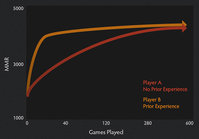- Joined
- May 29, 2007
- Messages
- 6,323
- Reaction score
- 1,136
In a move which may surprise and please a whole lot of people, Valve have recently announced that "Ranked Matchmaking" will be added to Dota 2 in the "next major update", which is widely believed to also feature the return of the Frostivus/Greeviling update from last year.
To explain what Ranked Matchmaking entails, the Dota 2 team have released a rather sizable blog post discussing how this new mode is likely to improve the matchmaking system for experienced players looking for a more competitive environment. Ranked Matchmaking will only be made available to players with a certain level of experience, as the mode features a large number of restrictions designed to keep the mode balanced and enjoyable for all. You can check out these restrictions and criteria in the spoiler tag below.
As explained, a system known as MMR (Matchmaking Ranking) is used to calculate the skill level of Dota 2 players during the matchmaking process. While MMR has previously only been used behind the scenes to group players and teams together, the ranking will be publicly visible for you and your friends to see for the first time in Ranked Matchmaking. MMR is updated at the conclusion of every match, using complex algorithms to calculate the performance of a player relative to the team mates and opponents they have been paired with. For example, players who beat opponents with an equal or higher MMR rank are likely to be rewarded with an increased ranking, while players who lose against opponents with an equal or lower rank are to be given a reduced score.
In theory, this system helps to balance out the matchmaking system, as players should always be pitted against evenly matched players with a ranking close to their own. The rate at which a player's MMR ranking shifts depends on multiple different factors, such as whether or not a player is partied up, and how experienced they are with the game, as shown below.

However, the MMR system is far more complex than this rather basic, so we recommend checking out the extremely lengthy blog post over on the Dota 2 website if you're interested in the game enough to want to learn more.
To explain what Ranked Matchmaking entails, the Dota 2 team have released a rather sizable blog post discussing how this new mode is likely to improve the matchmaking system for experienced players looking for a more competitive environment. Ranked Matchmaking will only be made available to players with a certain level of experience, as the mode features a large number of restrictions designed to keep the mode balanced and enjoyable for all. You can check out these restrictions and criteria in the spoiler tag below.
- Ranked matchmaking is unlocked after approximately 150 games.
- All players in the party must have unlocked the mode.
- Currently, only All Pick, Captains Mode, and Captains Draft are available.
- You may not participate in ranked matchmaking while in the low priority pool.
- Coaches are not allowed in ranked matchmaking.
- Matches played in normal matchmaking do not impact your ranked matchmaking MMR, and vice versa.
- Your ranked MMR is visible only to you and your friends. The MMR used for normal matchmaking is not visible.
- When you first start using ranked matchmaking, you will enter a calibration phase of 10 games. During this time, your ranked MMR will not be visible.
As explained, a system known as MMR (Matchmaking Ranking) is used to calculate the skill level of Dota 2 players during the matchmaking process. While MMR has previously only been used behind the scenes to group players and teams together, the ranking will be publicly visible for you and your friends to see for the first time in Ranked Matchmaking. MMR is updated at the conclusion of every match, using complex algorithms to calculate the performance of a player relative to the team mates and opponents they have been paired with. For example, players who beat opponents with an equal or higher MMR rank are likely to be rewarded with an increased ranking, while players who lose against opponents with an equal or lower rank are to be given a reduced score.
In theory, this system helps to balance out the matchmaking system, as players should always be pitted against evenly matched players with a ranking close to their own. The rate at which a player's MMR ranking shifts depends on multiple different factors, such as whether or not a player is partied up, and how experienced they are with the game, as shown below.
A graph featured on the Dota 2 blog designed to show the MMR of less experienced players may update differently to that of more experienced players.
However, the MMR system is far more complex than this rather basic, so we recommend checking out the extremely lengthy blog post over on the Dota 2 website if you're interested in the game enough to want to learn more.


